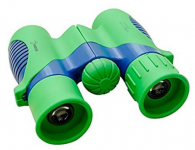Hi Becky, welcome to Bird Forum !

I have never heard of binocular viewing being bad for children. That said extreme care us be taken not to look toward the sun, and even bright reflections off water, or shiny metal etc may be unpleasant /harmful. As always, all things in moderation - I certainly think that looking at varying distances and focusing, as a child grows would be beneficial. More expensive binoculars will be built to an international standard which protects against UV light damage. Make sure the binoculars used meet this standard.
Apart from those very serious cautions, the main considerations are age/ size/ strength of the child. There are a number of suitable models at various price points, but excellent optics can be had for even ~$100. One of the main considerations for enjoyment and an acceptable view is how well the binocular fits the child's hands, and eyes. Not all binoculars are created equal, and it's very much an individual match up between the person and the fit of the binocular. Sometimes a heavier binocular is able to be held steadier and for longer because it simply 'fits' the person (little) better.
One key consideration is to make sure that the Interpupillary distance of the binocular suits the child (this is the distance between the center of the two pupils - measure it with a rule). The other thing to get right is the Eye Relief (the distance the eye surface is from the binocular eyepiece lens surface - this is done by twisting, or folding the eye cups out to the correct distance). If the person does not wear spectacles then this generally offers better choice at lower price points.
As far as magnification goes, there is not much benefit in practice to be had beyond 8.5x magnification due to slight hand shakes blurring the image. Suitable magnification are 6.5x, 7x, 8x, or 8.5x. The other part of the equation is the objective diameter. Bigger ones let in more light, but are heavier. Suitable sizes are 21mm - 32mm.
The weight of the bins might be 2 times or more than the one you mentioned - perhaps this will be OK? It is best to try in person (even little

before you buy to check the bin fits, is easy to hold steady, can be carried and used for sufficiently long periods, and has a wide clear, bright, sharp view. A Field of View (Fov) of ~400ft or over will be good.
Excellent (glass) binoculars can be had for $100-$200, or up to ~$400. Waterproof ones should last until adulthood.
I don't know the binoculars you have purchased. Some sizes to look at may be ~6.5x30, 8x26, 8x30, 8x32, 8.5x32 .....
Don't be put off by the 'old fashioned' looking ones (porro prisms) as these can often offer better bang for the buck performance.
An interesting one to look at is the 8.5x21 Papillo, which focuses about 3 times closer than normal, and can be lots of fun for kids looking at insects on flowers etc too.
Check out the big online retailers to get an idea of the models available. Maybe there is some sort of store nearby you to try in person. :cat:
https://www.eagleoptics.com/collections/binoculars/20-ounces-and-lower
Enjoy,
Chosun :gh:







